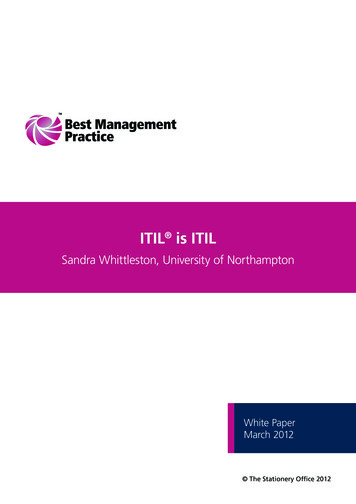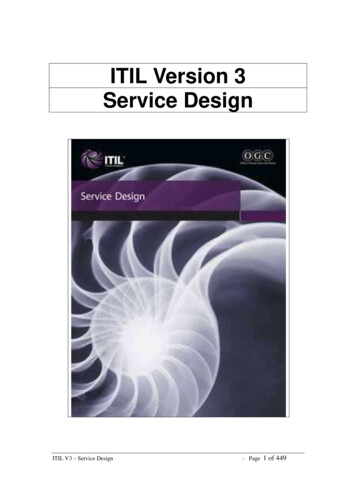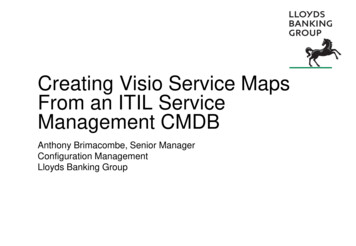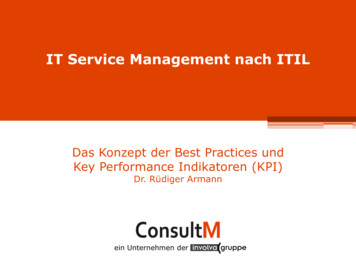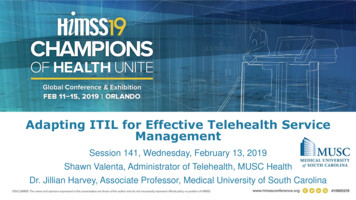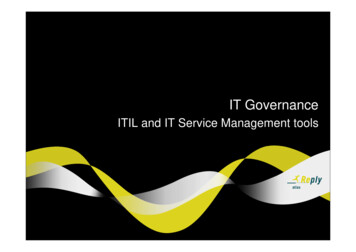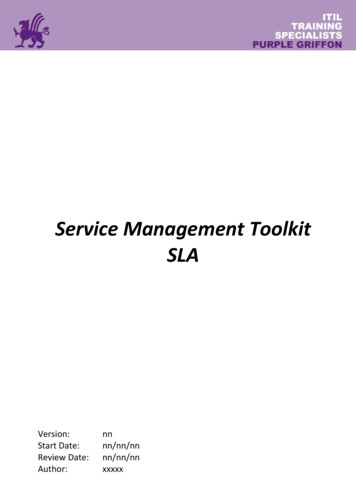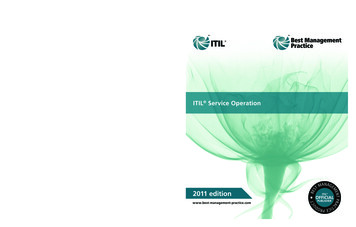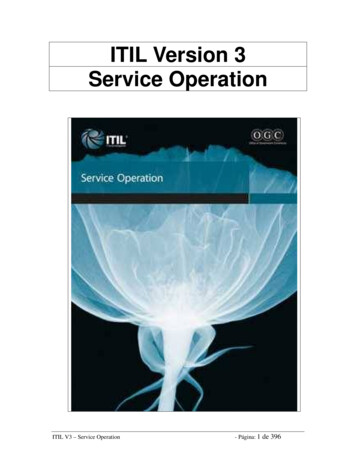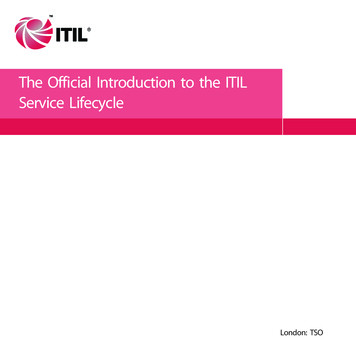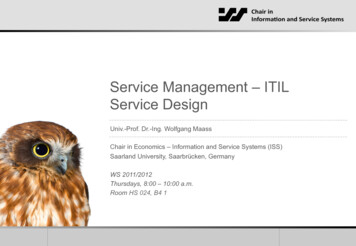
Transcription
Service Management – ITILService DesignUniv.-Prof. Dr.-Ing. Wolfgang MaassChair in Economics – Information and Service Systems (ISS)Saarland University, Saarbrücken, GermanyWS 2011/2012Thursdays, 8:00 – 10:00 a.m.Room HS 024, B4 1
General Agenda1. Introduction2. Service Strategy3. New Service Development (NSD)4. Service Quality5. Supporting Facility6. Forecasting Demand for Services7. Managing Demand8. Managing Capacity9. Managing Queues10. Capacity Planning and Queuing Models11. Services and Information Systems12. ITIL Service Design13. IT Service Infrastructures14. Summary and OutlookUniv.-Prof. Dr.-Ing. Wolfgang Maass25.01.12Slide 2
ITIL Service Lifecycle (ITIL V3)TodayService DesignLastlecture(OGC, 2011)Univ.-Prof. Dr.-Ing. Wolfgang Maass25.01.12 Design of new or changed servicesfor introduction into liveenvironment Guidance for designing anddeveloping services Converting strategic objectivesinto service portfolios and serviceassets; or improve existing services Development of design capabilitiesfor service managementSlide 3
Service CompositionUniv.-Prof. Dr.-Ing. Wolfgang Maass25.01.12Slide 4
ITIL Service DesignInputKey processes in ITILService DesignOutput① Design coordinationDesign ofservicesolution(Providing and maintainingsingle point of coordinationand control of all designactivities)② Service cataloguemanagement③ Service levelmanagement④ Availabilitymanagement⑤ Capacity management⑥ IT service continuitymanagement⑦ Information securitymanagement⑧ Supplier managementKeyservicedesignprocesses(OGC, 2011)Univ.-Prof. Dr.-Ing. Wolfgang Maass25.01.12Slide 5
Service Design – 2. Service CatalogueManagement Purpose Providing and maintaining a single source of consistent information on all operational services(service catalogue) and those being prepared to be run operationallyGaining common understanding of IT services of service provider between diverse stakeholdersContribution to definition of services and service packages and specification of interfaces anddependencies between service catalogue and service portfolio Definition of services and servicepackages Types of services in servicecataloguea) Customer-facing services –support customers business(seen by customer)b) Supporting services – supportcustomer-facing services (notseen by customer); also calledinfrastructure or technicalservices(OGC, 2011) Service package of customer iiSLA Service Level Agreementbetween service provider andcustomer (assures level ofservice quality (warranty))Univ.-Prof. Dr.-Ing. Wolfgang Maass25.01.12Slide 6
Service Design – 2. Service CatalogueManagement Structuring service catalogue Depends on audiences to be addressed –views for diverse audiencesMinimum: 2 different views – (1) business/customer, and (2) technical / supporting servicecatalogue viewFurther opportunity: 3 views, e.g., (1)wholesale, (2) retail, and (3) supporting servicecatalogue viewService catalogue exampleCustomers(understandportfolio of serviceprovider)Used by Staff membersUsers(which services areavailable; how to placeservice requests)(how supportingservices and serviceprovider assetssupport businessactivity)Univ.-Prof. Dr.-Ing. Wolfgang Maass25.01.12(OGC, 2011)Slide 7
Service Design – 3. Service LevelManagement Purpose Agreeing on and documenting service level targets andresponsibilities within SLAs and Service Level Requirements(SLR) for every service and related activityService level targets have to be appropriate and reflectrequirements of business① Designing SLA Frameworks Operational Level Agreement (OLA) agreement between IT service provider and partof same organization that supports delivery ofservices, e.g., facility department (OLA targetsunderpin those of SLA)Underpinning contracts contracts withexternal partners/suppliersTypes of SLAs:a)b) Service-based SLAs covering 1 serviceCustomer-based SLAs covering all services ofindividual customer groupMulti-level SLAs: (1) corporate level with generic SLM issues; (2) customerlevel with customer-/business-unit-specific SLM issues; (3) service level withservice-specific SLM issues with regard to customerUniv.-Prof. Dr.-Ing. Wolfgang Maass25.01.12Service Level Management(SLM)① Designing SLA Frameworks② Determining, documenting andagreeing requirements for newservices / Producing SLRs③ Negotiating, documenting andagreeing SLAs for operationalservices④ Monitoring service performanceagainst SLA⑤ Producing service reports⑥ Conducting service reviewsinstigating improvements withinoverall service improvementplan⑦ Collating, measuring andimproving customer satisfaction⑧ Review and revise SLAs andOLAs, underpinningagreements and service scope⑨ Develop contracts andrelationships⑩ Handling complaints and(OGC, 2011)complimentsSlide 8
Service Design – 3. Service LevelManagement② Determining, documenting andagreeing requirements for newservices / Producing SLRs Starts during service strategy phase Service level requirement (SLR) customer requirement for an aspect ofIT service SLRs used to negotiate service leveltargets SLRs relate primarily to warranty ofservice, e.g.,a)b)c)④ Monitoring serviceperformanceagainst SLAHow available does the service need to be?How secure?How quickly must it be restored if it shouldfail?③ Negotiating, documenting andagreeing SLAs for operationalservices Targets in SLAs originate from specifiedSLRs Only measurable targets, e.g., 99,5%availability of service⑤ Producing servicereports e.g., service levelagreement monitoring(SLAM) charts(OGC, 2011)Univ.-Prof. Dr.-Ing. Wolfgang Maass25.01.12Slide 9
Service Design – 4. AvailabilityManagement Availability ability of service to perform its agreedfunction when required Reliability how long service can perform agreed functionwithout interruption -- mean time between service incidents(MTBSI) and mean time between failures (MTBF) Maintainability how quickly and effectively a service canbe restored to normal working after failure (mean time torestore service (MTRS)) Serviceability ability of third-party supplier to meet termsof its contractPurpose Ensuring that level of availabilitydelivered in all IT services meets theagreed availability needs and servicelevel targets in cost-effective and timelymannerUniv.-Prof. Dr.-Ing. Wolfgang Maass25.01.12(OGC, 2011)Slide 10
Brainteaser10Minutes A 24 x 7 service has been running for a period of5020 hours with two breaks, one of six hours andone of 14 hours. Calculate the availability, reliability (mean timebetween service incidents and mean time betweenfailures) and maintainability of the service. Papers will be collected.Univ.-Prof. Dr.-Ing. Wolfgang Maass25.01.12Slide 11
Service Design – 4. AvailabilityManagementProactive activities, e.g.,Reactive activities, e.g.,Investigating all service and componentunavailability and instigating remedial action e.g., via expanded incident lifecycleMinimizing impact of incidentsMapping of total IT service downtime for anygiven incident against major stages ofincident progress (lifecycle)Planning and designing new or changed services e.g., component failure impact analysis (CFIA)Predict/evaluate impact on IT services arising fromcomponent failuresM alternative component available but needs manualintervention to be recoveredA alternative component availableX failure of component causes inoperative serviceblank failure of component does not impact service(OGC, 2011)Univ.-Prof. Dr.-Ing. Wolfgang Maass25.01.12Slide 12
ITIL Service DesignKey processes in ITIL ServiceDesign①②③④Design coordinationService catalogue managementService level managementAvailability management⑤ Capacity management(ensures that capacity of IT services / ITinfrastructure meets agreed capacity- andperformance-related requirements in costeffective and timely manner)⑥ IT service continuity management(ensures that IT provider can always provideminimum of agreed service levels)⑦ Information security management(ensures confidentiality, integrity, availabilityof organization assets, information, dataetc.)⑧ Supplier management(OGC, 2011)Univ.-Prof. Dr.-Ing. Wolfgang Maass25.01.12Slide 13
Service Design – 8. SupplierManagementPurpose Obtain value for money from suppliers to provide seamless quality of IT service to business Ensuring that all contracts and agreements with suppliers support needs of businessCategorization of suppliers Strategic suppliers significant “partnering”relationships; managed at senior management level Tactical suppliers significant commercial activityand business interaction; managed at middlemanagement e.g., hardware maintenance organizationOperational suppliers operational products andservices; managed at junior management e.g., worldwide network organizatione.g., internet hosting service providerCommodity suppliers low-value products/services e.g., supplier of printer paper(OGC, 2011)Univ.-Prof. Dr.-Ing. Wolfgang Maass25.01.12Slide 14
Real Life ExamplesProcter & Gamble Started using ITIL in 1999 6% to 8% cut on operating costs Help desk calls reduced by 10%Caterpillar Started using ITIL in 2000 Rate of achieving target response time for incidentmanagement on web-related services jumped from60% to 90%Capital One Started using ITIL in 2001 30% reduction in system crashes and softwaredistribution errors 92% reduction in “business-critical” incidentsUniv.-Prof. Dr.-Ing. Wolfgang Maass25.01.12(Kaiser, 2007)Slide 15
Critique Assumption: Many IT enterprises are looking for a magic bullet to end their IT chaos- Assumption: Often claimed "ITIL compliance" gives false impression that ITIL is an IT standard- But: ITIL is a set of best practices; ISO 20000 is an international standard “based” on ITILAssumption: Interactive and integrative nature of ITIL processes implies the entire frameworkhas to be implemented in an „all or nothing“ manner- But: Success with ITIL is largely dependent on determining how best, and when, to apply the processesin the IT organizationBut: Many organizations benefit from implementing only one or two ITIL processes such as changemanagement or incident managementAssumption: ITIL consists of a series of books that describe best practices in IT service areasan can be implemented out of the book-But: ITIL provides WHAT to do, not HOW to do it; it is not an instructional manual for IT leaders toimprove IT services and operations(Khan, 2008)Univ.-Prof. Dr.-Ing. Wolfgang Maass25.01.12Slide 16
A Handful of IT Service ManagementFrameworksControl OBjectives for Information and relatedTechnology (COBIT) Governance and control framework for ITmanagement by ISACA and IT Governance Institute;current version: COBIT 4.1 (2007)Defines 34 generic processes to manage ITPublications: „Core Content“, „IT Assurance Guide“,“Implementation Guide“ and „Control Practices“Relation to ITIL: COBIT is positioned at higher levelAligned and harmonized with other, more detailed, ITstandards and good practices such as ITILUniv.-Prof. Dr.-Ing. Wolfgang Maass25.01.12Slide 17
A Handful of IT Service ManagementFrameworksenhanced Telecom Operations Map (eTOM) Published by TeleManagement ForumDefines most widely used and accepted standard forbusiness processes in telecommunicationsindustryRelation to ITIL: eTOM seen as addition to ITILContrary to ITIL, eTOM offers data model for eachdetailed process because telecommunicationcompanies often need to interchange data -- focus ondelivery of transparent services throughout severalcompaniesVendor frameworks based on ITIL e.g., MS Operations Framework (MOF) as basis ofMS System Center Service Manager [1]e.g., HP ITSM services based on ITIL [2]Univ.-Prof. Dr.-Ing. Wolfgang Maass25.01.12Slide 18
Outlook1. Introduction2. Service Strategy3. New Service Development (NSD)4. Service Quality5. Supporting Facility6. Forecasting Demand for Services7. Managing Demand8. Managing Capacity9. Managing Queues10. Capacity Planning and Queuing Models11. Services and Information Systems12. ITIL Service Design13. IT Service Infrastructures14. Summary and OutlookUniv.-Prof. Dr.-Ing. Wolfgang Maass25.01.12Slide 19
Literature Kaiser, T. "ITIL: What is it? Why you should use it? How to use it?", PPT, 2007.Khan, I. A. "Myths and Realities about ITIL", PPT, 2008.Office of Government Commerce (OGC), ITIL Service Design, The Stationery Office (TSO), London, 2011.Spaulding, G. "What’s New in ITIL v3", PPT, 2007.Web: [1] /articles/495298.mspx[2] html?compURI tcm:144-809129&pageTitle ITSMServices?404m rt404mb,newcclltow1en#Univ.-Prof. Dr.-Ing. Wolfgang Maass25.01.12Slide 20
Univ.-Prof. Dr.-Ing. Wolfgang MaassChair in Information and Service SystemsSaarland University, GermanyUniv.-Prof. Dr.-Ing. Wolfgang Maass
Assumption: ITIL consists of a series of books that describe best practices in IT service areas an can be implemented out of the book - But: ITIL provides WHAT to do, not HOW to do it; it is not an instructional manual for IT leaders to improve IT services and operations (Khan, 2008) Univ.-Prof. Dr.-Ing. Wolfgang Maass ! 25.01.12 Slide 17! A Handful of IT Service Management Frameworks .

